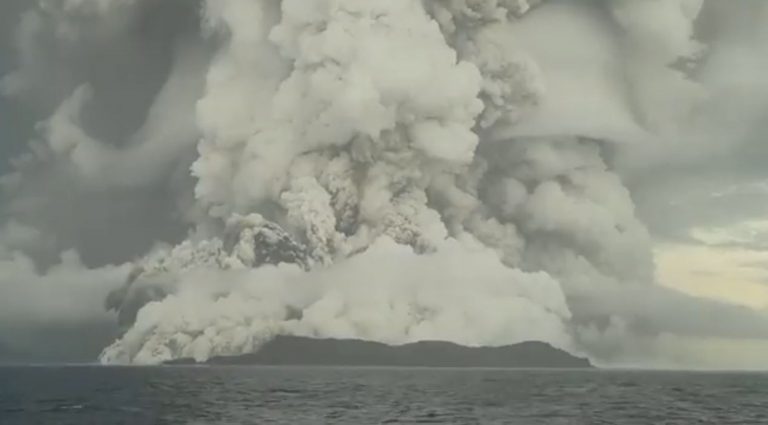On Jan. 15, a massive undersea volcanic eruption took place near Tonga, a Polynesian nation comprising of over 170 islands that is home to around 100,000 people. The eruption of the Hunga-Tonga-Hunga-Ha’apai volcano, which sits underwater at around 2,000 meters above the seafloor, resulted in multiple tsunami warnings being issued across the world. Tonga is located about 1,500 miles from New Zealand and 500 miles from Fiji.
The volcano’s most recent eruption began in December last year, with ash plumes, steam, and gas rising up to 7.5 miles in the air. On Jan. 14, the volcano erupted once again, and the next day, a massive eruption took place, sending shock waves around the world. Interestingly, the volcano has been active since Dec. 20 but was declared dormant on Jan. 11, just three days before the Jan.14 eruption.
According to Emily Lane, a scientist at New Zealand’s National Institute of Water and Atmospheric Research, the volcanic eruption was a “very significant one,” with the shock wave from the blast “clearly visible” in satellite imagery. People in faraway places like New Zealand are said to have heard the sound of the eruption. A sonic boom was heard in Alaska as well.
Professor Shane Cronin from the School of Environment at the University of Auckland believes the current eruption could last for several weeks or months based on the volcano’s past eruptions.
“The eruption is likely to result in significant ash fall (up to 10 centimeters) in Tongatapu as well as the Ha’apai group of islands… Help will be needed to restore drinking water supplies. People of Tonga must also remain vigilant for further eruptions and especially tsunami with short notice and should avoid low-lying areas,” Cronin told the New Zealand Science Media Center.
Success
You are now signed up for our newsletter
Success
Check your email to complete sign up
The volcanic eruption has severed the internet connection to Tonga, cutting off the island from the outside world. Citizens of Tonga were left unable to contact family or friends.
Communications largely remained shut down for around 48 hours. A 50-year-old UK woman who used to run a tattoo parlor in Tonga was reported missing after being swept away by the resulting tsunami.
In a Facebook video, a woman from Tonga, who was hiding at her family’s home, said that she was keeping herself safe from the tiny rock pieces that continuously fell from the sky and the volcanic ash which turned the sky pitch black.
People who were outside were carrying umbrellas for protection. “It’s really bad. They told us to stay indoors and cover our doors and windows because it’s dangerous… I felt sorry for the people. Everyone just froze when the explosion happened. We rushed home,” she said in a video.
Both Australia and New Zealand have sent surveillance flights to Tonga to assess the damage. Though no mass casualties have been reported, officials have cautioned not to be too optimistic about it as the communications systems were hit and the full situation remains to be known. New Zealand sent an Orion aircraft to assist in the “initial impact assessment” of the region.
“Australia’s P-8 surveillance flight has departed to Tonga this morning to assess the situation on the ground. Australia stands ready to provide every possible support to the people of Tonga following the devastating tsunami,” Zed Seselja, Australia’s minister for the Pacific, tweeted on Jan. 17.
In addition to Tonga, tsunami alerts were issued for Japan, Alaska, Hawaii, and the U.S. Pacific Coast. In the United States, the tsunami advisory was initially issued in the states of Alaska, California, Washington, and Oregon.
These advisories were lifted by Sunday morning. The highest waves were seen in port San Luis, California at 4.3 feet, followed by King Cove in Alaska at 3.7 feet and Crescent city California at 3.7 feet.


















